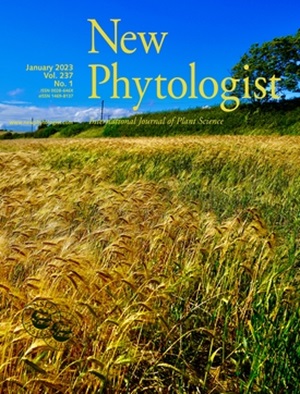miR825-5p-regulated TNLs govern Arabidopsis resistance to Tetranychus urticae and Pieris brassicae.
IF 8.1
1区 生物学
Q1 PLANT SCIENCES
引用次数: 0
Abstract
MicroRNAs are essential regulators in plant resistance to biotic stresses, but their specific roles in the plant-herbivore context require deeper investigation. Here, we studied how the Arabidopsis miR825-5p differentially modulates certain TNLs (MRT1, MRT2, and MIST1), triggering defensive responses against the sucking acari Tetranychus urticae or the chewing insect Pieris brassicae. We demonstrated that the expression of miR825-5p is downregulated following T. urticae and P. brassicae infestation and identified miRNA TNL targets whose expression is induced by both feeders. miR825-5p downregulates MRT1 and MRT2, acting as a negative modulator of Arabidopsis basal resistance against T. urticae. A similar miR825-5p-mediated regulation of basal resistance, including MRT1 and MRT2 but also MIST1 silencing, is involved in the Arabidopsis response against P. brassicae. Moreover, miR825-5p triggered the production of MIST1-derived secondary interfering RNAs (phasiRNAs) and amplified silencing of MRT1 and MRT2. Taken together, our findings reveal the role of the miR825-5p/TNL module in controlling Arabidopsis response and adapting plant defenses based on the specific threat.mir825 -5p调控的tnl调控拟南芥对荨麻叶螨和芸苔螟的抗性。
microrna是植物抵抗生物胁迫的重要调节因子,但它们在植物-草食动物环境中的具体作用需要深入研究。在这里,我们研究了拟南芥miR825-5p如何差异调节某些tnl (MRT1, MRT2和MIST1),从而触发对荨麻叶螨(Tetranychus urticae)或咀嚼昆虫(Pieris brassicae)的防御反应。我们证明了miR825-5p的表达在荨苔虫和芸苔虫侵染后下调,并鉴定了miRNA TNL靶点,其表达是由两种取食者诱导的。miR825-5p下调MRT1和MRT2,作为拟南芥对金黄色葡萄球菌基础抗性的负调控因子。类似的mir825 -5p介导的基础抗性调控,包括MRT1和MRT2,以及MIST1沉默,参与拟南芥对芸苔菌的应答。此外,miR825-5p触发了mist1衍生的次级干扰rna (phasiRNAs)的产生,并放大了MRT1和MRT2的沉默。综上所述,我们的研究结果揭示了miR825-5p/TNL模块在控制拟南芥反应和基于特定威胁的植物防御中的作用。
本文章由计算机程序翻译,如有差异,请以英文原文为准。
求助全文
约1分钟内获得全文
求助全文
来源期刊

New Phytologist
生物-植物科学
自引率
5.30%
发文量
728
期刊介绍:
New Phytologist is an international electronic journal published 24 times a year. It is owned by the New Phytologist Foundation, a non-profit-making charitable organization dedicated to promoting plant science. The journal publishes excellent, novel, rigorous, and timely research and scholarship in plant science and its applications. The articles cover topics in five sections: Physiology & Development, Environment, Interaction, Evolution, and Transformative Plant Biotechnology. These sections encompass intracellular processes, global environmental change, and encourage cross-disciplinary approaches. The journal recognizes the use of techniques from molecular and cell biology, functional genomics, modeling, and system-based approaches in plant science. Abstracting and Indexing Information for New Phytologist includes Academic Search, AgBiotech News & Information, Agroforestry Abstracts, Biochemistry & Biophysics Citation Index, Botanical Pesticides, CAB Abstracts®, Environment Index, Global Health, and Plant Breeding Abstracts, and others.
 求助内容:
求助内容: 应助结果提醒方式:
应助结果提醒方式:


